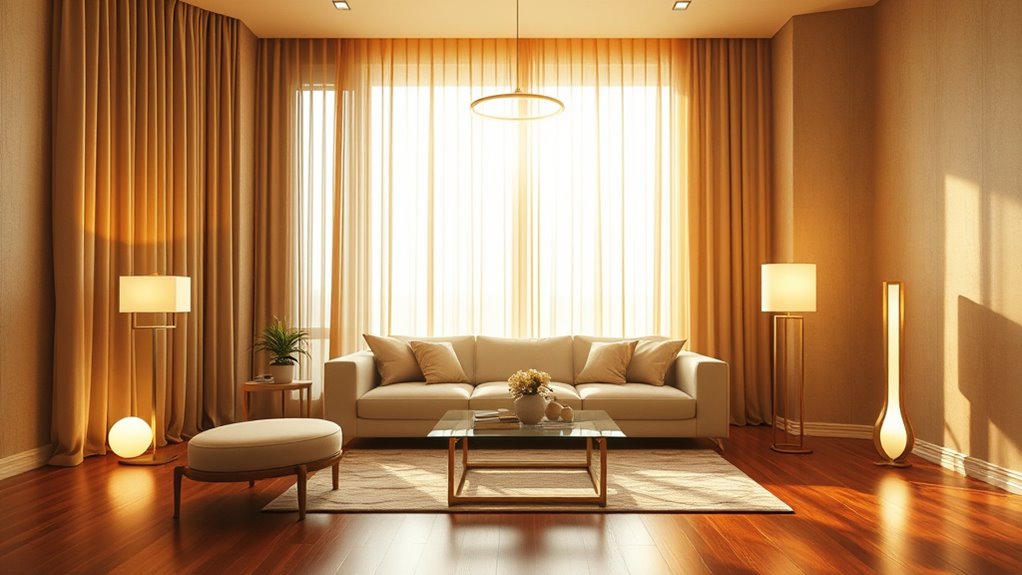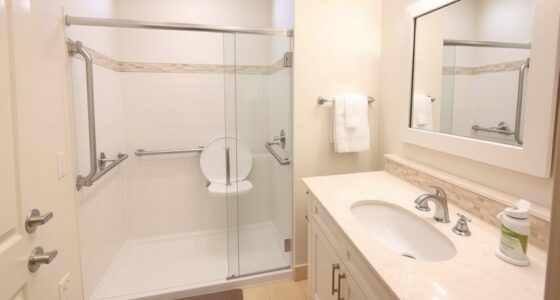To improve visibility in every room, start by combining ambient and task lighting to create a balanced space. Use dimmable fixtures to adjust brightness easily for different activities. Incorporate layered lighting, like ceiling lights for overall glow and focused lamps for tasks. Position lights strategically to prevent shadows and strain. Opt for warmer or cooler bulbs based on the room’s purpose. Keep exploring for more tips to make your space brighter and more functional.
Key Takeaways
- Incorporate layered lighting by combining ambient and task lights for balanced illumination.
- Use dimmable fixtures to adjust brightness according to activity and mood.
- Position task lighting to avoid shadows and enhance focus in specific areas.
- Choose appropriate bulb color temperatures to match activities, such as cooler for work and warmer for relaxation.
- Maximize natural light during the day and complement it with strategic artificial lighting.

Good lighting is essential for clear visibility, especially in low-light conditions. When you’re trying to read, cook, or work, proper illumination makes all the difference. One effective way to enhance your space is by balancing ambient glow with task lighting. Ambient glow refers to the soft, overall illumination that fills a room, creating a welcoming atmosphere and reducing harsh shadows. Task lighting, on the other hand, focuses on specific areas where you need precise visibility—like a desk, kitchen counter, or bathroom mirror. By combining these two types of lighting, you ensure your space is both functional and comfortable.
Start with ambient glow. Use ceiling fixtures, wall sconces, or even LED strip lights to bathe your room in a gentle, even light. This prevents dark corners and minimizes eye strain. You want the ambient glow to be sufficient for general movement and to set the mood without overpowering the space or causing glare. For example, in a living room, a ceiling-mounted fixture or recessed lights can provide this soft background illumination. In bedrooms or cozy nooks, dimmable lights work well, allowing you to adjust the ambiance based on your needs or mood.
Start with ambient glow using ceiling fixtures, sconces, or LED strips to create a soft, even room illumination.
Next, focus on task lighting. This type should be targeted and brighter, directed precisely where you need clear visibility. If you’re reading or working at a desk, a dedicated desk lamp with adjustable brightness helps you see details without straining your eyes. In the kitchen, under-cabinet lights illuminate countertops, making food prep safer and easier. Bathroom vanity lights should be bright enough to mimic natural daylight, helping you apply makeup or shave accurately. The key is to position task lights so they don’t cast shadows on your work area and to choose bulbs with a color temperature that matches your activity—cooler light for tasks requiring accuracy, warmer light for relaxation.
Combining ambient glow with task lighting isn’t just about brightness; it’s about creating layers that serve different functions seamlessly. Use dimmers to control the intensity of your ambient lighting, so you can easily switch from bright to subdued as needed. Pairing this with adjustable task lights ensures you have the right amount of illumination exactly where you need it, without waste or discomfort. This approach also reduces eye fatigue and improves overall visibility, making your space more inviting and practical.
In every room, thoughtful lighting setup can transform your environment. By intentionally layering ambient glow with task lighting, you enhance visibility and comfort, whether you’re reading a book, preparing meals, or simply relaxing. This balance ensures your space is both beautiful and functional, tailored perfectly to your daily activities. Additionally, considering advanced lighting options can further optimize your space, especially in areas with specific needs or limited natural light.
Frequently Asked Questions
How Can Smart Lighting Enhance Room Visibility Effectively?
Smart lighting enhances room visibility by allowing you to adjust brightness levels instantly, ensuring you see clearly. With voice control, you can easily modify lighting without interrupting your activities, making adjustments simple and quick. Ambient lighting creates a balanced environment, reducing shadows and glare. These features work together to improve visibility effectively, making your space more functional and comfortable, whether you’re working, relaxing, or performing detailed tasks.
What Colors of Light Are Best for Improving Visibility?
To improve visibility, you should focus on selecting the right light color. A higher color temperature, around 4000K to 5000K, offers a bright, cool light that enhances clarity and detail. Opt for daylight or cool white light, as it mimics natural daylight and reduces eye strain. Adjust your light color to match tasks, ensuring you get the best visibility while creating a comfortable environment.
How Does Natural Light Impact Interior Lighting Choices?
Natural light is your brightest, most powerful tool for interior lighting. It influences your choices by highlighting window placement and enabling daylight harvesting, which maximizes sunlight during the day. You should strategically position windows to flood rooms with sunlight and use shades or reflective surfaces to control glare. Embracing natural light creates a warm, inviting atmosphere while reducing energy costs, making your space feel alive and vibrant all day long.
Are There Eco-Friendly Lighting Options to Improve Visibility?
You can choose eco-friendly lighting options like LED bulbs, which use less energy and last longer, reducing waste. Installing solar panels can power your lighting sustainably, decreasing your carbon footprint. These options not only improve visibility but also support environmental conservation. By switching to LED bulbs and harnessing solar energy, you make smarter, greener choices that benefit both your home and the planet.
How Should Lighting Be Adjusted for Different Activities and Tasks?
For different activities, you should adjust your lighting by using task-specific lighting for focused tasks like reading or cooking, ensuring it’s bright enough without causing glare. Combine this with ambient lighting to create a comfortable overall brightness. Switch between these layers as needed, and consider dimmers for flexibility. This approach helps you optimize visibility and comfort, making every activity easier and more enjoyable.
Conclusion
Think of your rooms like a stage—bright lighting reveals every detail, making your space come alive. I once struggled in a dimly lit kitchen until a simple switch to brighter bulbs transformed it into a lively hub, much like turning on a spotlight. Proper lighting doesn’t just see to your eyes; it sets the tone for your entire space. With these tricks, you’ll brighten every room and make your home truly shine.









